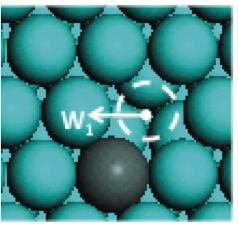Solute strengthening and dynamic strain aging (topics addressed elsewhere) have both been studied mainly within binary Al-X alloys and Al-5XXX Al-Mg alloys.

We have recently studied solute effects in Al-6XXX alloys with the aim of controlling natural and artificial aging processes. In collaboration with careful experimental studies by colleagues at ETHZ, we have shown that dilute concentrations (100 ppm) of some solutes, like Sn, can slow down natural aging considerably – by up to two weeks – and accelerate artificial aging. We have postulated that these results are caused by the trapping of vacancies by the solutes. This trapping slows down all kinetic processes controlled by vacancy diffusion, and this includes precipitate aging processes. However, at elevated temperatures, the vacancies are released from the solutes, allowing artificial aging to proceed. DFT methods are used to compute the solute-vacancy binding energies, and migration barriers to verify that the solute-vacancy complexes do not diffuse anomalously fast. A statistical mechanical model for how the vacancies are partitioned among the matrix and solutes, upon quenching, predicts the residual vacancy concentration in the matrix. The model predicts the delays in natural aging at low T.
We are currently studying some aspects of Al-Li alloys. We are investigating whether quantum methods can predict the observed substantial increase in Young’s modulus (7-10%) achieved by additions of 3-5% Li in solution. We are also analyzing Li-Li interactions to understand factors controlling the formation of various precipitate phases, in particular the meta-stable delta’ Al-Li phase. We expect to apply our solute strengthening and dynamic strain aging models to Al-Li as well, aiming to explain these phenomena quantitatively.
Key publications:
- S. Pogatscher et al., Diffusion on Demand : solving the natural aging problem in Al-6061, Physical Review Letters (2014).